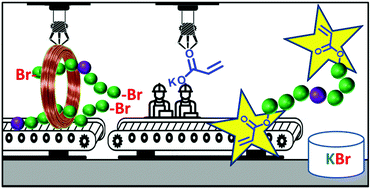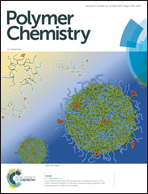Macromonomers, telechelics and more complex architectures of PMA by a combination of biphasic SET-LRP and biphasic esterification
Abstract
The high bromine chain end functionality of polyacrylates synthesized by single electron transfer living radical polymerization (SET-LRP) mediated by TREN in a biphasic acetone–water mixture containing Cu(II)Br2 can be exploited to introduce specific functional groups to the chain-ends of these polymers. Here, the α-bromoester end groups of poly(methyl acrylate) (PMA) synthesized in this biphasic SET-LRP system using non-activated Cu(0) wire as catalyst were reacted also under heterogeneous biphasic conditions with potassium acrylate to yield PMA macromonomers and telechelics with α- and α,ω-acrylate chain ends. The reagents used in both steps are air insensitive and inexpensive. 500 MHz 1H NMR, GPC and MALDI-TOF analyses in combination with the thio-bromo “click” reaction were used to confirm the high efficiency of this two-step protocol. The reactive nature of these macromonomers by the preparation of a PMA-g-PMA more complex architecture was also demonstrated.

- This article is part of the themed collection: Frontiers in Supramolecular and Macromolecular Science symposia


 Please wait while we load your content...
Please wait while we load your content...